BSBMGT502 - Design and Train Effective Performance Management Systems
VerifiedAdded on 2023/06/12
|6
|1380
|130
Report
AI Summary
This report details the design and training of performance management systems, particularly in the context of Woolongong. It covers arranging role-play scenarios with assessors, suggesting amendments to existing performance management systems to ensure fairness and effectiveness, and planning training sessions that cover goal setting, feedback mechanisms, performance appraisal processes, and the importance of record-keeping. The report emphasizes aligning training with organizational goals, developing employee potential, and addressing inefficiencies. It also highlights the benefits of the proposed amendments, including improved employee motivation, ethical considerations, and the use of neutral parties in performance appraisals. The overall aim is to create a dependable and fair performance management system that supports employee development and organizational success. Desklib offers more solved assignments and past papers for students.
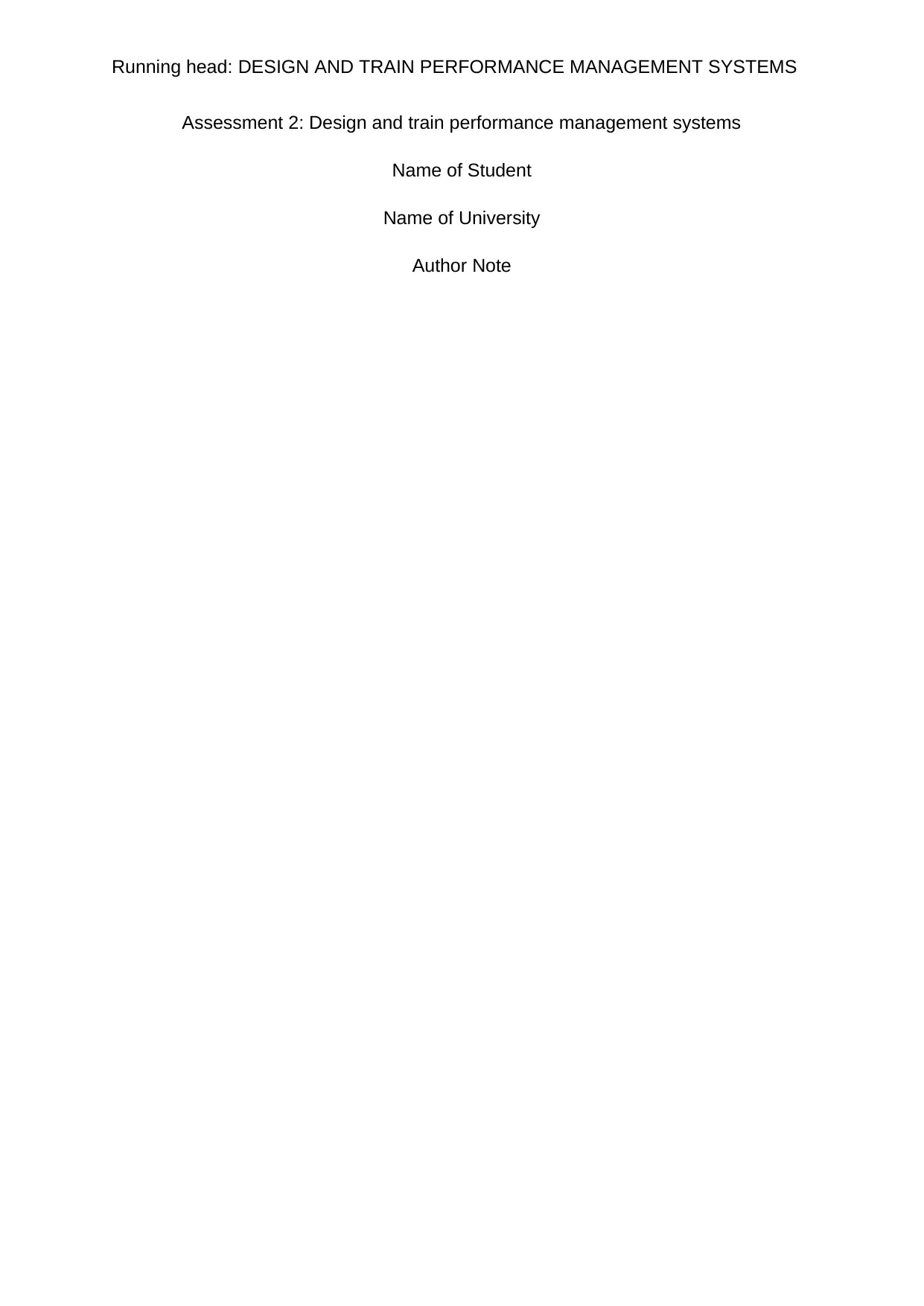
Running head: DESIGN AND TRAIN PERFORMANCE MANAGEMENT SYSTEMS
Assessment 2: Design and train performance management systems
Name of Student
Name of University
Author Note
Assessment 2: Design and train performance management systems
Name of Student
Name of University
Author Note
Paraphrase This Document
Need a fresh take? Get an instant paraphrase of this document with our AI Paraphraser
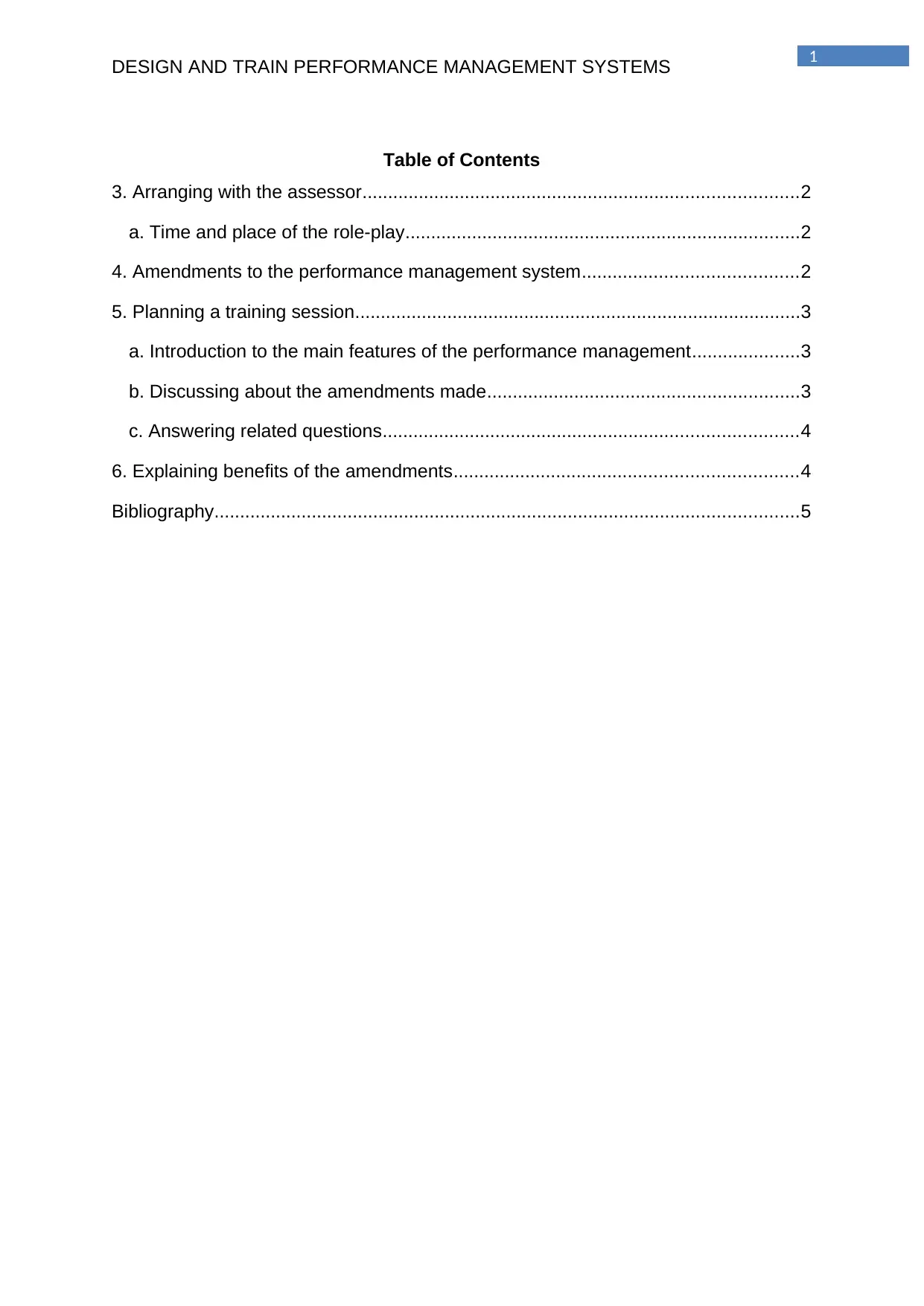
1
DESIGN AND TRAIN PERFORMANCE MANAGEMENT SYSTEMS
Table of Contents
3. Arranging with the assessor.....................................................................................2
a. Time and place of the role-play.............................................................................2
4. Amendments to the performance management system..........................................2
5. Planning a training session.......................................................................................3
a. Introduction to the main features of the performance management.....................3
b. Discussing about the amendments made.............................................................3
c. Answering related questions.................................................................................4
6. Explaining benefits of the amendments...................................................................4
Bibliography..................................................................................................................5
DESIGN AND TRAIN PERFORMANCE MANAGEMENT SYSTEMS
Table of Contents
3. Arranging with the assessor.....................................................................................2
a. Time and place of the role-play.............................................................................2
4. Amendments to the performance management system..........................................2
5. Planning a training session.......................................................................................3
a. Introduction to the main features of the performance management.....................3
b. Discussing about the amendments made.............................................................3
c. Answering related questions.................................................................................4
6. Explaining benefits of the amendments...................................................................4
Bibliography..................................................................................................................5
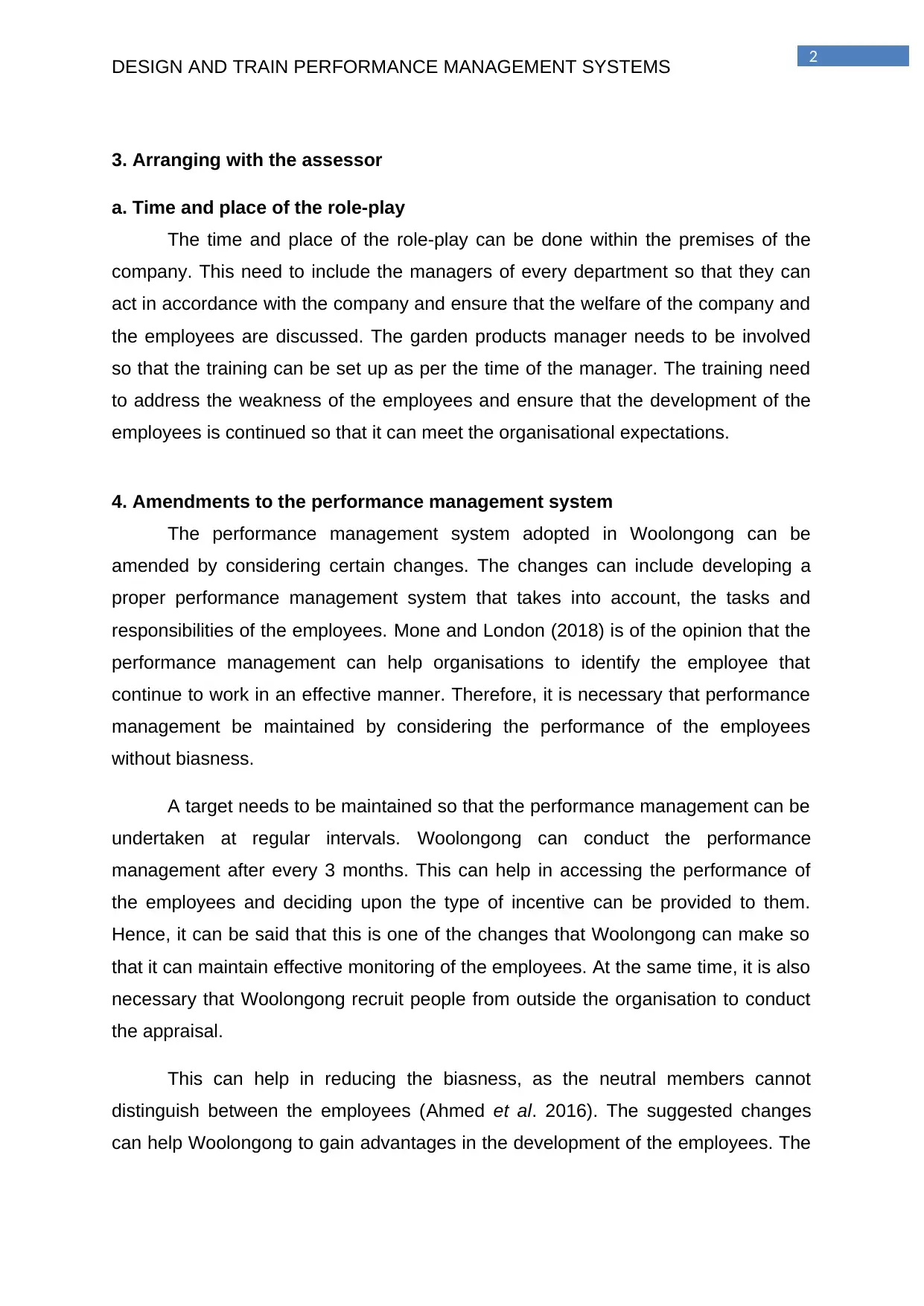
2
DESIGN AND TRAIN PERFORMANCE MANAGEMENT SYSTEMS
3. Arranging with the assessor
a. Time and place of the role-play
The time and place of the role-play can be done within the premises of the
company. This need to include the managers of every department so that they can
act in accordance with the company and ensure that the welfare of the company and
the employees are discussed. The garden products manager needs to be involved
so that the training can be set up as per the time of the manager. The training need
to address the weakness of the employees and ensure that the development of the
employees is continued so that it can meet the organisational expectations.
4. Amendments to the performance management system
The performance management system adopted in Woolongong can be
amended by considering certain changes. The changes can include developing a
proper performance management system that takes into account, the tasks and
responsibilities of the employees. Mone and London (2018) is of the opinion that the
performance management can help organisations to identify the employee that
continue to work in an effective manner. Therefore, it is necessary that performance
management be maintained by considering the performance of the employees
without biasness.
A target needs to be maintained so that the performance management can be
undertaken at regular intervals. Woolongong can conduct the performance
management after every 3 months. This can help in accessing the performance of
the employees and deciding upon the type of incentive can be provided to them.
Hence, it can be said that this is one of the changes that Woolongong can make so
that it can maintain effective monitoring of the employees. At the same time, it is also
necessary that Woolongong recruit people from outside the organisation to conduct
the appraisal.
This can help in reducing the biasness, as the neutral members cannot
distinguish between the employees (Ahmed et al. 2016). The suggested changes
can help Woolongong to gain advantages in the development of the employees. The
DESIGN AND TRAIN PERFORMANCE MANAGEMENT SYSTEMS
3. Arranging with the assessor
a. Time and place of the role-play
The time and place of the role-play can be done within the premises of the
company. This need to include the managers of every department so that they can
act in accordance with the company and ensure that the welfare of the company and
the employees are discussed. The garden products manager needs to be involved
so that the training can be set up as per the time of the manager. The training need
to address the weakness of the employees and ensure that the development of the
employees is continued so that it can meet the organisational expectations.
4. Amendments to the performance management system
The performance management system adopted in Woolongong can be
amended by considering certain changes. The changes can include developing a
proper performance management system that takes into account, the tasks and
responsibilities of the employees. Mone and London (2018) is of the opinion that the
performance management can help organisations to identify the employee that
continue to work in an effective manner. Therefore, it is necessary that performance
management be maintained by considering the performance of the employees
without biasness.
A target needs to be maintained so that the performance management can be
undertaken at regular intervals. Woolongong can conduct the performance
management after every 3 months. This can help in accessing the performance of
the employees and deciding upon the type of incentive can be provided to them.
Hence, it can be said that this is one of the changes that Woolongong can make so
that it can maintain effective monitoring of the employees. At the same time, it is also
necessary that Woolongong recruit people from outside the organisation to conduct
the appraisal.
This can help in reducing the biasness, as the neutral members cannot
distinguish between the employees (Ahmed et al. 2016). The suggested changes
can help Woolongong to gain advantages in the development of the employees. The
⊘ This is a preview!⊘
Do you want full access?
Subscribe today to unlock all pages.

Trusted by 1+ million students worldwide
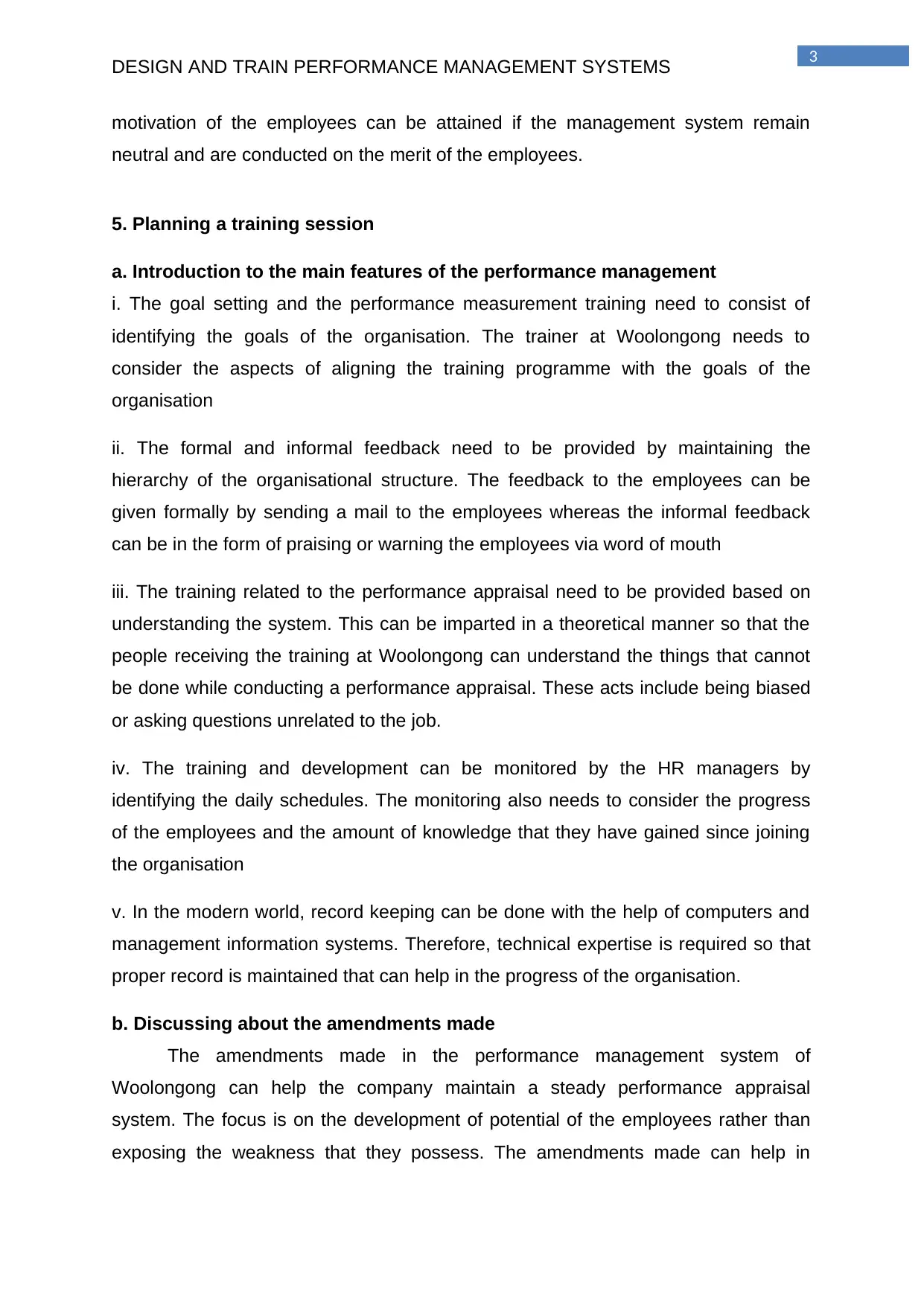
3
DESIGN AND TRAIN PERFORMANCE MANAGEMENT SYSTEMS
motivation of the employees can be attained if the management system remain
neutral and are conducted on the merit of the employees.
5. Planning a training session
a. Introduction to the main features of the performance management
i. The goal setting and the performance measurement training need to consist of
identifying the goals of the organisation. The trainer at Woolongong needs to
consider the aspects of aligning the training programme with the goals of the
organisation
ii. The formal and informal feedback need to be provided by maintaining the
hierarchy of the organisational structure. The feedback to the employees can be
given formally by sending a mail to the employees whereas the informal feedback
can be in the form of praising or warning the employees via word of mouth
iii. The training related to the performance appraisal need to be provided based on
understanding the system. This can be imparted in a theoretical manner so that the
people receiving the training at Woolongong can understand the things that cannot
be done while conducting a performance appraisal. These acts include being biased
or asking questions unrelated to the job.
iv. The training and development can be monitored by the HR managers by
identifying the daily schedules. The monitoring also needs to consider the progress
of the employees and the amount of knowledge that they have gained since joining
the organisation
v. In the modern world, record keeping can be done with the help of computers and
management information systems. Therefore, technical expertise is required so that
proper record is maintained that can help in the progress of the organisation.
b. Discussing about the amendments made
The amendments made in the performance management system of
Woolongong can help the company maintain a steady performance appraisal
system. The focus is on the development of potential of the employees rather than
exposing the weakness that they possess. The amendments made can help in
DESIGN AND TRAIN PERFORMANCE MANAGEMENT SYSTEMS
motivation of the employees can be attained if the management system remain
neutral and are conducted on the merit of the employees.
5. Planning a training session
a. Introduction to the main features of the performance management
i. The goal setting and the performance measurement training need to consist of
identifying the goals of the organisation. The trainer at Woolongong needs to
consider the aspects of aligning the training programme with the goals of the
organisation
ii. The formal and informal feedback need to be provided by maintaining the
hierarchy of the organisational structure. The feedback to the employees can be
given formally by sending a mail to the employees whereas the informal feedback
can be in the form of praising or warning the employees via word of mouth
iii. The training related to the performance appraisal need to be provided based on
understanding the system. This can be imparted in a theoretical manner so that the
people receiving the training at Woolongong can understand the things that cannot
be done while conducting a performance appraisal. These acts include being biased
or asking questions unrelated to the job.
iv. The training and development can be monitored by the HR managers by
identifying the daily schedules. The monitoring also needs to consider the progress
of the employees and the amount of knowledge that they have gained since joining
the organisation
v. In the modern world, record keeping can be done with the help of computers and
management information systems. Therefore, technical expertise is required so that
proper record is maintained that can help in the progress of the organisation.
b. Discussing about the amendments made
The amendments made in the performance management system of
Woolongong can help the company maintain a steady performance appraisal
system. The focus is on the development of potential of the employees rather than
exposing the weakness that they possess. The amendments made can help in
Paraphrase This Document
Need a fresh take? Get an instant paraphrase of this document with our AI Paraphraser
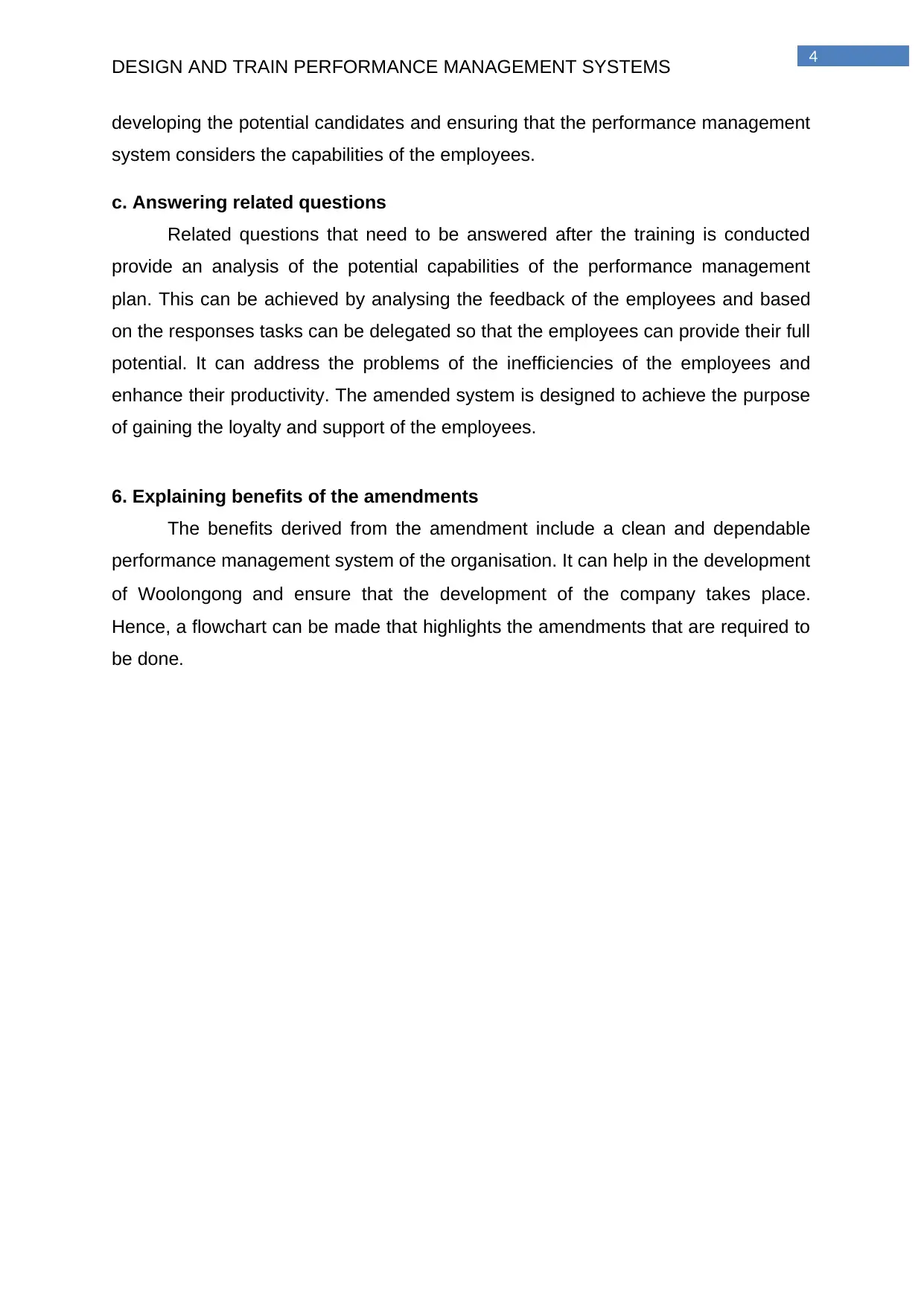
4
DESIGN AND TRAIN PERFORMANCE MANAGEMENT SYSTEMS
developing the potential candidates and ensuring that the performance management
system considers the capabilities of the employees.
c. Answering related questions
Related questions that need to be answered after the training is conducted
provide an analysis of the potential capabilities of the performance management
plan. This can be achieved by analysing the feedback of the employees and based
on the responses tasks can be delegated so that the employees can provide their full
potential. It can address the problems of the inefficiencies of the employees and
enhance their productivity. The amended system is designed to achieve the purpose
of gaining the loyalty and support of the employees.
6. Explaining benefits of the amendments
The benefits derived from the amendment include a clean and dependable
performance management system of the organisation. It can help in the development
of Woolongong and ensure that the development of the company takes place.
Hence, a flowchart can be made that highlights the amendments that are required to
be done.
DevelopmentofpropertrainingmethodsforthepurposeofimprovingtheefficiencyoftheemployeesMaintainethicalconsiderationsothatbiasnessdoesnotprevailwhileconductingtheappraisalEnsurethattheneutralpeopleconducttheperformanceapprasialtoreducethechancesofanytypeofbiasness
DESIGN AND TRAIN PERFORMANCE MANAGEMENT SYSTEMS
developing the potential candidates and ensuring that the performance management
system considers the capabilities of the employees.
c. Answering related questions
Related questions that need to be answered after the training is conducted
provide an analysis of the potential capabilities of the performance management
plan. This can be achieved by analysing the feedback of the employees and based
on the responses tasks can be delegated so that the employees can provide their full
potential. It can address the problems of the inefficiencies of the employees and
enhance their productivity. The amended system is designed to achieve the purpose
of gaining the loyalty and support of the employees.
6. Explaining benefits of the amendments
The benefits derived from the amendment include a clean and dependable
performance management system of the organisation. It can help in the development
of Woolongong and ensure that the development of the company takes place.
Hence, a flowchart can be made that highlights the amendments that are required to
be done.
DevelopmentofpropertrainingmethodsforthepurposeofimprovingtheefficiencyoftheemployeesMaintainethicalconsiderationsothatbiasnessdoesnotprevailwhileconductingtheappraisalEnsurethattheneutralpeopleconducttheperformanceapprasialtoreducethechancesofanytypeofbiasness
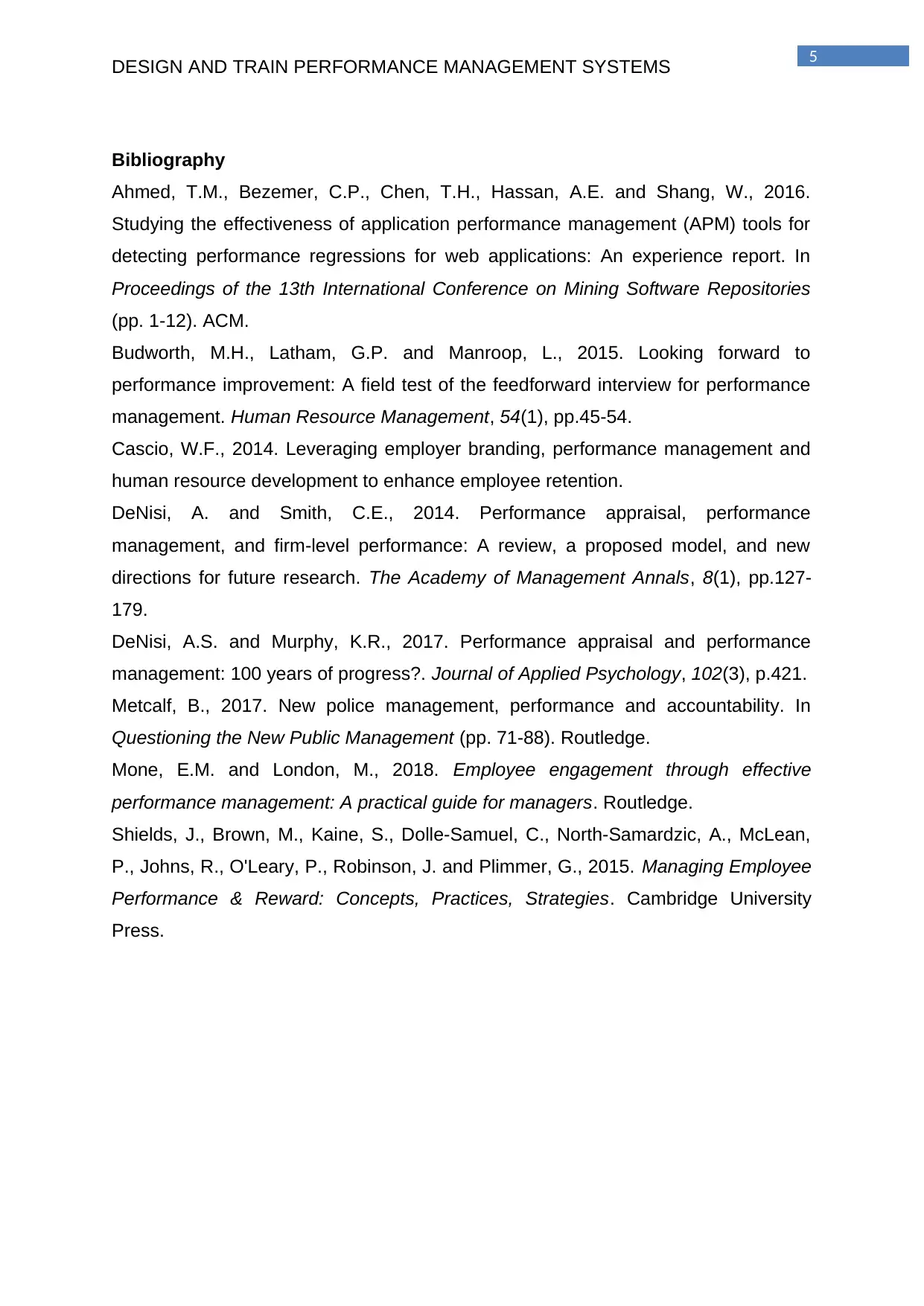
5
DESIGN AND TRAIN PERFORMANCE MANAGEMENT SYSTEMS
Bibliography
Ahmed, T.M., Bezemer, C.P., Chen, T.H., Hassan, A.E. and Shang, W., 2016.
Studying the effectiveness of application performance management (APM) tools for
detecting performance regressions for web applications: An experience report. In
Proceedings of the 13th International Conference on Mining Software Repositories
(pp. 1-12). ACM.
Budworth, M.H., Latham, G.P. and Manroop, L., 2015. Looking forward to
performance improvement: A field test of the feedforward interview for performance
management. Human Resource Management, 54(1), pp.45-54.
Cascio, W.F., 2014. Leveraging employer branding, performance management and
human resource development to enhance employee retention.
DeNisi, A. and Smith, C.E., 2014. Performance appraisal, performance
management, and firm-level performance: A review, a proposed model, and new
directions for future research. The Academy of Management Annals, 8(1), pp.127-
179.
DeNisi, A.S. and Murphy, K.R., 2017. Performance appraisal and performance
management: 100 years of progress?. Journal of Applied Psychology, 102(3), p.421.
Metcalf, B., 2017. New police management, performance and accountability. In
Questioning the New Public Management (pp. 71-88). Routledge.
Mone, E.M. and London, M., 2018. Employee engagement through effective
performance management: A practical guide for managers. Routledge.
Shields, J., Brown, M., Kaine, S., Dolle-Samuel, C., North-Samardzic, A., McLean,
P., Johns, R., O'Leary, P., Robinson, J. and Plimmer, G., 2015. Managing Employee
Performance & Reward: Concepts, Practices, Strategies. Cambridge University
Press.
DESIGN AND TRAIN PERFORMANCE MANAGEMENT SYSTEMS
Bibliography
Ahmed, T.M., Bezemer, C.P., Chen, T.H., Hassan, A.E. and Shang, W., 2016.
Studying the effectiveness of application performance management (APM) tools for
detecting performance regressions for web applications: An experience report. In
Proceedings of the 13th International Conference on Mining Software Repositories
(pp. 1-12). ACM.
Budworth, M.H., Latham, G.P. and Manroop, L., 2015. Looking forward to
performance improvement: A field test of the feedforward interview for performance
management. Human Resource Management, 54(1), pp.45-54.
Cascio, W.F., 2014. Leveraging employer branding, performance management and
human resource development to enhance employee retention.
DeNisi, A. and Smith, C.E., 2014. Performance appraisal, performance
management, and firm-level performance: A review, a proposed model, and new
directions for future research. The Academy of Management Annals, 8(1), pp.127-
179.
DeNisi, A.S. and Murphy, K.R., 2017. Performance appraisal and performance
management: 100 years of progress?. Journal of Applied Psychology, 102(3), p.421.
Metcalf, B., 2017. New police management, performance and accountability. In
Questioning the New Public Management (pp. 71-88). Routledge.
Mone, E.M. and London, M., 2018. Employee engagement through effective
performance management: A practical guide for managers. Routledge.
Shields, J., Brown, M., Kaine, S., Dolle-Samuel, C., North-Samardzic, A., McLean,
P., Johns, R., O'Leary, P., Robinson, J. and Plimmer, G., 2015. Managing Employee
Performance & Reward: Concepts, Practices, Strategies. Cambridge University
Press.
⊘ This is a preview!⊘
Do you want full access?
Subscribe today to unlock all pages.

Trusted by 1+ million students worldwide
1 out of 6
Related Documents
Your All-in-One AI-Powered Toolkit for Academic Success.
+13062052269
info@desklib.com
Available 24*7 on WhatsApp / Email
![[object Object]](/_next/static/media/star-bottom.7253800d.svg)
Unlock your academic potential
Copyright © 2020–2025 A2Z Services. All Rights Reserved. Developed and managed by ZUCOL.




